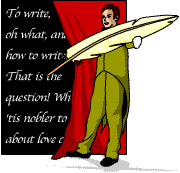Mental Maps
Created | Updated Nov 25, 2012
Words, words, words. That's what we're made of. Herewith some of my thoughts on what we're doing with them.
Writing Right with Dmitri: Mental Maps

When you read, it makes pictures in your head. What kind of pictures do you get in your head when you read this?
Mrs. Fairfax stayed behind a moment to fasten the trap-door; I, by drift of groping, found the outlet from the attic, and proceeded to descend the narrow garret staircase. I lingered in the long passage to which this led, separating the front and back rooms of the third storey: narrow, low, and dim, with only one little window at the far end, and looking, with its two rows of small black doors all shut, like a corridor in some Bluebeard’s castle. – Charlotte Bronte, Jane Eyre
You know you're in an attic. What do you see in your mind? If you're familiar with Victorian houses, you can probably form a fairly clear picture of this garret. But what if you're someone from the US who has never lived in an area with old houses, say, the Southwest? What if your idea of an attic is that there's a pull-down folding ladder leading to a crawlspace full of insulation and bare beams? Well, you're going to have to make it up visually as you go along.
How do we make up spaces in our heads? Oh, sure, it's fine if you want to describe a busy railway station, particularly one you visit often. It's like drawing from life, or a photograph: you just describe what you see. But what if you're describing a space that's not there any more, like a castle on the Rhine, which you may only have seen in ruins? Or a marketplace in ancient Egypt?
You probably do what I do: mentally superimpose the desired space on one you're already familiar with.
This habit of mine grew out of my early dreamlife. As a kid, I didn't know too many different buildings. A lot of my dreams took place in my school building, or the old house that served as extra Sunday-School space for my church. Places like that. It wasn't significant. The spaces just provided four walls, a door, and maybe a staircase or two. This happens to me still: I'll find myself dreaming of a house or apartment. Whatever the action is, when I wake up and remember the imagery, I often think, 'Oh, that was based on the place we rented in the fall of 1976. I wonder why I dreamed of that?'
We cut and paste like that all the time. And we do it when we're writing.
When you write yourself a house, a garden, a castle (with or without moat), whatever, you describe it from visual memory. The reader conjures up a similar picture – and he's probably using the photo file in his head. Kind of an interesting way to do it. That also means that the more familiar the reader is with this kind of space, the more accurate his picture will be, no matter what you write – provided you've got the basics right.
For example, a New England reader will picture a Stephen King house better than I will, but I'll do better with John Grisham, because we're from the same home city. When he talks about unpainted houses in northern Mississippi, I know exactly what he's talking about. I've slept in houses like that. But I'm only able to approximate when King talks about a 'saltbox'.
But once you do that, you've got to make mental adjustments. After all, the attic in the story isn't exactly like the one in your head. Maybe the window's on the other side. Or it's bigger, or smaller. There's furniture in there. You're constantly revising the picture in your head. There's even more cutting and pasting going on.

Think about your favourite TV shows – the ones that take place in a house, or on a starship. Those places are also pasted together, from all sorts of sets and sound stages. Back in the 1960s, the Gothic soap opera Dark Shadows took up most of a city block in New York. But Collinwood, that great estate, was all in pieces. In order to go upstairs, the actors had to mount the onscreen staircase, go through the door, then run down a corridor, up the stairs (marked 'Barnabas, don't forget your fangs,' and arrive at milady's bedroom, pretending not to be out of breath.
Western towns are Potemkin villages. TV houses are two sets and some establishing outside shots. And the buildings in our stories are cobbled together from our jumble of memories. Fun, that – and a challenge to describe.
The Addams Family lives in a house which was originally inspired by one the cartoonist used to pass every day in Germantown, a section of Philadelphia. I wonder what manse served as the model for Manderley? Oh, wait, I've just found it: Menabilly, a house Daphne du Maurier rented in Fowey, Cornwall. I remember Fowey – Cactuscafe stayed there a while back, and told us about Daphne. CC also included a beautiful photo of an antique lift there. Now, if I want to describe someone travelling in an old lift, I can use that picture.
Bit by bit, we make those maps in our heads. Potemkin villages they may be, these sets, but we and our readers will fill in the details.
Writing Right with Dmitri Archive
